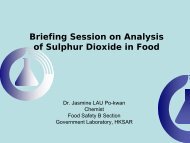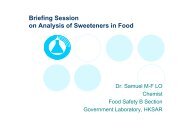Briefing Session on Analysis of Nitrate/Nitrite and ... - uri=govtlab.gov
Briefing Session on Analysis of Nitrate/Nitrite and ... - uri=govtlab.gov
Briefing Session on Analysis of Nitrate/Nitrite and ... - uri=govtlab.gov
Create successful ePaper yourself
Turn your PDF publications into a flip-book with our unique Google optimized e-Paper software.
CC<strong>on</strong>tents t t<br />
<strong>Nitrate</strong>/<strong>Nitrite</strong> Testing Methods<br />
Propi<strong>on</strong>ic acid Testing Methods<br />
Certified Reference Materials<br />
Pr<strong>of</strong>iciency Tests
<strong>Nitrate</strong>/<strong>Nitrite</strong><br />
INS: 249, 250, 251, 252<br />
• Functi<strong>on</strong>al Uses: Antimicrobial preservative<br />
Colour l fixative f<br />
• 5 – 20 mg/kg <strong>of</strong> free HNO 2 redden meat<br />
• 50 mg/kg producti<strong>on</strong> <strong>of</strong> characteristic taste<br />
• > 100 mg/kg antimicrobial effects<br />
• Too much nitrosamines Carcinogenic g
<strong>Nitrate</strong>/<strong>Nitrite</strong> Background :<br />
PPreservatives ti in i Food F dR Regulati<strong>on</strong> l ti (Cap (C 132BD)<br />
Item Column 1<br />
Specified food<br />
PART I<br />
ARTICLES OF FOOD WHICH MAY CONTAIN PRESERVATIVE AND THE NATURE<br />
AND PROPORTION OF PRESERVATIVE IN EACH CASE<br />
Column 2<br />
Permitted preservative<br />
1. Bac<strong>on</strong> Sodium nitrate<br />
Sodium nitrite<br />
Column 3<br />
Parts per milli<strong>on</strong> not<br />
exceeding<br />
500<br />
200<br />
8. Cheese, other than Cheddar or Sodium nitrate or 100<br />
Cheshire type cheese or s<strong>of</strong>t<br />
cheese<br />
sodium nitrite 10<br />
44. Ham Sodium nitrate<br />
500<br />
Sodium nitrite 200<br />
54. Meat, pickled, cooked Sodium nitrate<br />
500<br />
Sodium nitrite<br />
200<br />
55. Meat, ,p pickled, , uncooked Sodium nitrate 500<br />
Sodium nitrite 200<br />
62. Pork, preserved Sodium nitrate<br />
500<br />
Sodium nitrite<br />
200<br />
72. Sausage, Chinese preserved Sodium nitrate<br />
500<br />
Sodium nitrite<br />
200
Sample Types
H 2 NO 2 S<br />
Nit <strong>Nitrate</strong>/<strong>Nitrite</strong>: t /Nit it Spectroscopic S t i Detecti<strong>on</strong> D t ti<br />
Sulfanilamide<br />
NO 3 -<br />
Cd<br />
/ <strong>Nitrate</strong> reductase + NADPH<br />
NO - 2<br />
NH 2<br />
Griess Reacti<strong>on</strong><br />
H 2 O<br />
N<br />
H<br />
H N<br />
N<br />
H2NO2S N 2NO2S N<br />
2+ H<br />
NH 2<br />
N-1-napthylethylenediamine (NED)<br />
Azo Compound (red colour)<br />
C<strong>on</strong>centrati<strong>on</strong> <strong>of</strong> NO 3 - = C<strong>on</strong>centrati<strong>on</strong> <strong>of</strong> NO2 - after reducti<strong>on</strong><br />
– C<strong>on</strong>centrati<strong>on</strong> <strong>of</strong> NO 2 - without reducti<strong>on</strong><br />
NH 2
<strong>Nitrate</strong>/<strong>Nitrite</strong>: Internati<strong>on</strong>al St<strong>and</strong>ard Methods based <strong>on</strong> Griess Recti<strong>on</strong><br />
St<strong>and</strong>ards Methods<br />
ISO 2918-1975 (E) Meat <strong>and</strong> meat products – Determinati<strong>on</strong> <strong>of</strong> nitrite c<strong>on</strong>tent<br />
ISO 3091-1975 (E) Meat <strong>and</strong> meat products – Determinati<strong>on</strong> <strong>of</strong> nitrite c<strong>on</strong>tent<br />
BS 1743-16.1 1983 Methods for <strong>Analysis</strong> <strong>of</strong> dried milk <strong>and</strong> dried milk products –<br />
Part 16: Determinati<strong>on</strong> <strong>of</strong> nitrate <strong>and</strong> nitrite c<strong>on</strong>tents<br />
Secti<strong>on</strong> 16.1 Method for dried milk by cadmium reducti<strong>on</strong><br />
BS 770-9:1985 Methods for Chemical analysis y <strong>of</strong> cheese –<br />
Part 9: Determinati<strong>on</strong> <strong>of</strong> nitrate <strong>and</strong> nitrite c<strong>on</strong>tent – Cadmium reducti<strong>on</strong> <strong>and</strong> photometry method<br />
BS EN 12014-3:1997 Foodstuffs – Determinati<strong>on</strong> <strong>of</strong> nitrate <strong>and</strong>/or nitrite c<strong>on</strong>tent –<br />
Part 3: Spectrometric determinati<strong>on</strong> <strong>of</strong> nitrate <strong>and</strong> nitrite c<strong>on</strong>tent <strong>of</strong> meat products after enzymatic<br />
reducti<strong>on</strong> <strong>of</strong> nitrate to nitrite<br />
BS EN 12014-7:1997 Foodstuffs – Determinati<strong>on</strong> <strong>of</strong> nitrate <strong>and</strong>/or nitrite c<strong>on</strong>tent –<br />
Part 7: C<strong>on</strong>tinuous flow method for the determinati<strong>on</strong> <strong>of</strong> nitrate c<strong>on</strong>tent <strong>of</strong> vegetables <strong>and</strong><br />
vegetable products after cadmium reducti<strong>on</strong><br />
BS EN ISO 14673 14673-1:2004 1:2004 Milk <strong>and</strong> milk products – Determinati<strong>on</strong> <strong>of</strong> nitrate <strong>and</strong> nitrite c<strong>on</strong>tents<br />
Part 1: Method using cadmium reducti<strong>on</strong> <strong>and</strong> spectrometry<br />
BS EN ISO 14673-2:2004 Milk <strong>and</strong> milk products – Determinati<strong>on</strong> <strong>of</strong> nitrate <strong>and</strong> nitrite c<strong>on</strong>tents<br />
Part 2: Method using segmented flow analysis (Routine method)<br />
BS EN ISO 14673-3:2004 Milk <strong>and</strong> milk products – Determinati<strong>on</strong> <strong>of</strong> nitrate <strong>and</strong> nitrite c<strong>on</strong>tents<br />
Part 3: Method using cadmium reducti<strong>on</strong> <strong>and</strong> flow injecti<strong>on</strong> analysis with in-line dialysis (Routine<br />
method)<br />
AOAC 976.14 <strong>Nitrate</strong> <strong>and</strong> Nitite in Cheese – Modified J<strong>on</strong>es Reducti<strong>on</strong> Method<br />
AOAC 973.31 <strong>Nitrite</strong> in Cured Meat – Colorimetric Method<br />
AOAC 993.03 <strong>Nitrate</strong> in Baby Foods – Spectrophotometric method
<strong>Nitrate</strong>/<strong>Nitrite</strong>: Internati<strong>on</strong>al St<strong>and</strong>ard Methods –Other techniques<br />
St<strong>and</strong>ards Methods Techniques<br />
AOAC 935.48 <strong>Nitrate</strong>s <strong>and</strong> <strong>Nitrite</strong>s in Meat – Xylenol Method Covert nitrite to nitrate by KMnO4 Nitrati<strong>on</strong> <strong>of</strong> Xylenol<br />
MMeasure th the [NO -<br />
3 ]<br />
BS EN 12014-4:<br />
1997<br />
BS EN 12014-5:<br />
1997<br />
BS EN 12014-2:<br />
1997<br />
Foodstuffs – Determinati<strong>on</strong> <strong>of</strong> nitrate <strong>and</strong>/or nitrite c<strong>on</strong>tent –<br />
Part 4: I<strong>on</strong>-exchange chromatographic (IC) method for the<br />
determinati<strong>on</strong> <strong>of</strong> nitrate <strong>and</strong> nitrite c<strong>on</strong>tent <strong>of</strong> meat products<br />
Foodstuffs – Determinati<strong>on</strong> <strong>of</strong> nitrate <strong>and</strong>/or nitrite c<strong>on</strong>tent –<br />
Part 5: Enzymatic determinati<strong>on</strong> <strong>of</strong> nitrate c<strong>on</strong>tent <strong>of</strong> vegetablec<strong>on</strong>taining<br />
food for babies <strong>and</strong> infants<br />
Foodstuffs – Determinati<strong>on</strong> <strong>of</strong> nitrate <strong>and</strong>/or nitrite c<strong>on</strong>tent –<br />
Part 2: HPLC/IC method for the determinati<strong>on</strong> <strong>of</strong> nitrate c<strong>on</strong>tent <strong>of</strong><br />
vegetables <strong>and</strong> vegetable products<br />
I<strong>on</strong>-chromatography with UV<br />
detector<br />
Enzymatic reducti<strong>on</strong> by nitrate<br />
reductase <strong>and</strong> NADPH<br />
Measure the difference <strong>of</strong><br />
[NADPH]<br />
I<strong>on</strong>-chromatography with<br />
c<strong>on</strong>ductivity detector/<br />
HPLC with UV detecter<br />
GB/T 5009.33- 5009.33 食品中亚硝酸盐与硝酸盐的测定 Cd reducti<strong>on</strong><br />
2003<br />
Measure [NO -<br />
2 ] by Griess<br />
method or c<strong>on</strong>ductivity
<strong>Nitrate</strong>/<strong>Nitrite</strong>: GL Methods<br />
(i) Flow Injecti<strong>on</strong> <strong>Analysis</strong> Method<br />
(ii) I<strong>on</strong> I<strong>on</strong>-chromatography chromatography Method
Nit <strong>Nitrate</strong>/<strong>Nitrite</strong>: t /Nit it GL Method M th d – FIA method th d<br />
Sample Extracti<strong>on</strong><br />
Meat <strong>and</strong> Meat Products Cheese Products<br />
Vegetable <strong>and</strong><br />
Vegetable Products
<strong>Nitrate</strong>/<strong>Nitrite</strong>: GL Testing method for Meat <strong>and</strong> Meat Products<br />
1. Homogenize the sample<br />
g p<br />
2. Weigh 10 g <strong>of</strong> comminuted sample<br />
3. + 100 mL hot water + 5 mL borax soluti<strong>on</strong><br />
4. + 0.5 g activated charcoal.
Nit <strong>Nitrate</strong>/<strong>Nitrite</strong>: t /Nit it GL Testing T ti method th d for f Meat M t <strong>and</strong> d Meat M t Products P d t<br />
5. Heat for 15 minutes <strong>on</strong> a boiling water bath.<br />
66. Allow to cool <strong>and</strong> add 2 mL Carrez Carrez Solut<strong>on</strong> Solut<strong>on</strong> I <strong>and</strong> II II. Swirl Swirl after each additi<strong>on</strong>. additi<strong>on</strong><br />
7. Add 5 mL borax soluti<strong>on</strong> <strong>and</strong> transfer to a 200-mL volumetric flask.<br />
8. After st<strong>and</strong>ing for 30 minutes, make up to the mark with water, mix <strong>and</strong> filter<br />
through g a Whatman No. 41 filter paper. p p<br />
•Carrez Soluti<strong>on</strong> I: 10.6 g potassium<br />
ferrocyanide (II) (K 4[Fe(CN) 6].3H 2O) in<br />
distilled water<br />
•Carrez Soluti<strong>on</strong> II: 22.0 g zinc acetate<br />
<strong>and</strong> 3 mL glacial acetic acid in distilled<br />
water <strong>and</strong> dilute to 100 mL.<br />
NO -<br />
3 NO -<br />
2<br />
Cd<br />
Measure the NO -<br />
2 level
<strong>Nitrate</strong>/<strong>Nitrite</strong>: GL Testing method for Cheese Products<br />
Reference to BS EN ISO 14673-3:2004<br />
1. Grind or comminute the sample.<br />
2. Weigh accurately <strong>of</strong> 2.5 g comminuted samples to a 50- 50<br />
mL centrifuge tube.<br />
3. Add 24 mL <strong>of</strong> extracti<strong>on</strong> buffer soluti<strong>on</strong><br />
Buffer soluti<strong>on</strong> :26.6 g <strong>of</strong> NH4Cl + c<strong>on</strong>centrated NH3 in 1L<br />
water (pH~8.5) (p )<br />
4. Preheated to a temperature <strong>of</strong> 50oCto55oC. 5. Mix with the homogenizer for about 3 minutes until the<br />
test porti<strong>on</strong> is well suspended.<br />
Milk <strong>and</strong> milk products –<br />
Determinati<strong>on</strong> <strong>of</strong> nitrate<br />
<strong>and</strong> nitrite c<strong>on</strong>tents<br />
Part 3: Method using<br />
cadmium reducti<strong>on</strong> <strong>and</strong><br />
flow injecti<strong>on</strong> j analysis y with<br />
in-line dialysis (Routine<br />
method)
<strong>Nitrate</strong>/<strong>Nitrite</strong>: GL Testing method for Cheese Products<br />
6. Centrifuge at 2000 rpm for 5 minutes.<br />
7. Place the centrifuge tube in a mixture <strong>of</strong> water <strong>and</strong> ice for 15 minutes to cool the test<br />
soluti<strong>on</strong>.<br />
8. Pipette p the de-fatted test soluti<strong>on</strong> from underneath the fat layer y in the centrifuge g tube.<br />
NO -<br />
3 NO -<br />
2<br />
Cd<br />
Measure the NO -<br />
2 level
<strong>Nitrate</strong>/<strong>Nitrite</strong>: C<strong>on</strong>versi<strong>on</strong> <strong>of</strong> <strong>Nitrate</strong> to <strong>Nitrite</strong><br />
In the past past…….. Now<br />
Flow Injecti<strong>on</strong> <strong>Analysis</strong> (FIA)
<strong>Nitrate</strong>/<strong>Nitrite</strong>: GL Testing method – Flow Injecti<strong>on</strong> <strong>Analysis</strong><br />
Dialysis Cell<br />
From<br />
Dialysis Cell<br />
Sufanilamide + NED<br />
Sample<br />
Cd column
Nit <strong>Nitrate</strong>/<strong>Nitrite</strong>: t /Nit it Flow Fl Injecti<strong>on</strong> I j ti <strong>Analysis</strong> A l i C<strong>on</strong>diti<strong>on</strong> C diti<br />
Buffer / Carrier: Amm<strong>on</strong>ium chloride buffer soluti<strong>on</strong> (Carrier <strong>and</strong> Buffer):<br />
1. 53.2 g NH4Cl + 1800 mL distilled dei<strong>on</strong>ized water in a 2 L volumetric flask.<br />
22. Adj Adjust pH H to 8.5 8 5 ± 00.1 1 with i h 15N sodium di hydroxide h d id soluti<strong>on</strong> l i ddropwise. i<br />
3. Make up to the mark with distilled dei<strong>on</strong>ized water.<br />
Sulphanilamide/NED colour reagent:<br />
1. 100 mL 85% phosphoric acid + 40.0 g sulphanilamide + 1.0 g <strong>of</strong> NED in about 1L<br />
distilled dei<strong>on</strong>ized water.<br />
2. Store in a dark bottle.<br />
Washbath<br />
Dissolve 1 g <strong>of</strong> Tween 20 in 4 L distilled dei<strong>on</strong>ized water.<br />
Buffer + sample<br />
Carrier<br />
Sulphanilamide/<br />
NED colour reagent<br />
Dialysis Cell<br />
‐‐‐‐‐‐‐‐‐‐‐<br />
Cd Column<br />
Waste<br />
Detector<br />
540nm
Nit <strong>Nitrate</strong>/<strong>Nitrite</strong>: t /Nit it Typical T i l Flow Fl Injecti<strong>on</strong> I j ti <strong>Analysis</strong> A l i <strong>of</strong> f <strong>Nitrite</strong><br />
Nit it
<strong>Nitrate</strong>/<strong>Nitrite</strong>: Typical Flow Injecti<strong>on</strong> <strong>Analysis</strong> <strong>of</strong> <strong>Nitrate</strong>
Notes<br />
1. Use nitrate/nitrite free filter paper<br />
2. Pre-rinsed all glasswares, volumetric flasks<br />
with distilled dei<strong>on</strong>ized water before use<br />
3. Tween 20 is essential for getting good<br />
precisi<strong>on</strong> results<br />
44. Method blank is needed for correcti<strong>on</strong> correcti<strong>on</strong>.<br />
5. Check Cd column performance
Reporting Limits<br />
Nit <strong>Nitrite</strong> it (as ( sodium di nitrite) it it ) 5 mg/kg /k<br />
<strong>Nitrate</strong> (as sodium nitrate) 30 mg/kg
Alternative Technique q – I<strong>on</strong> Chromatography g p y<br />
Reference to BS EN 12014-4:2005<br />
For those samples<br />
having c<strong>on</strong>centrati<strong>on</strong><br />
> legal limit<br />
Foodstuffs – Determinati<strong>on</strong> <strong>of</strong><br />
nitrate <strong>and</strong>/or nitrite c<strong>on</strong>tent<br />
- Part 4: I<strong>on</strong>-exchange<br />
chromatographic h t hi (IC) method th d<br />
for the determinati<strong>on</strong> <strong>of</strong> nitrate<br />
<strong>and</strong> nitrite c<strong>on</strong>tent <strong>of</strong> meat<br />
products
I<strong>on</strong> Chromatography determinati<strong>on</strong> <strong>of</strong> <strong>Nitrate</strong> <strong>and</strong> <strong>Nitrite</strong><br />
1. Weigh 10 g <strong>of</strong> comminuted sample <strong>and</strong> add about 50 mL 60 o Cwater<br />
2. Mix thoroughly g y after the additi<strong>on</strong>. Swirl <strong>and</strong> s<strong>on</strong>icate the sample p soluti<strong>on</strong> for 10 minutes.<br />
3. Transfer the sample into a 200-mL volumetric flask. Add 50 mL <strong>of</strong> acet<strong>on</strong>itrile to the 200-mL<br />
volumetric flask <strong>and</strong> mix gently.<br />
44. Allow to cool to room temperature temperature, make up to the mark with water water, mix <strong>and</strong> filter through a<br />
Whatman No. 41 filter paper<br />
5. The soluti<strong>on</strong> is further filtered through a membrane filter <strong>of</strong> pore size <strong>of</strong> approximately 0.45μm.<br />
I<strong>on</strong> Chromatography with UV detector
I<strong>on</strong> Chromatography c<strong>on</strong>diti<strong>on</strong> <strong>of</strong> <strong>Nitrate</strong> <strong>and</strong> <strong>Nitrite</strong><br />
C l W t IC P TM Column : Waters IC-Pac A i HC 150 4 6<br />
TM Ani<strong>on</strong> HC 150 x 4.6 mm<br />
column<br />
Mobile phase : Lithium borate gluc<strong>on</strong>ate buffer in<br />
acet<strong>on</strong>itrile/water (pH~6.5)<br />
Flow rate : 1.0 mL/min.<br />
DDetector t t : UV<br />
Quantitati<strong>on</strong><br />
Wavelength g<br />
: 205 nm<br />
Injecti<strong>on</strong> volume : 40 µL
I<strong>on</strong> Chromatogram<br />
St<strong>and</strong>ard<br />
3 ppm NaNO2 5 ppm pp NaNO 3<br />
Sample Spike<br />
15 ppm NaNO2 30 ppm NaNO3 Sample Spike<br />
100 ppm NNaNO NO2<br />
250 ppm NaNO3
Method Comparis<strong>on</strong><br />
Liquid Chromatographic Determinati<strong>on</strong> <strong>of</strong> Residual <strong>Nitrite</strong>/nitrate in Foods: NMKL Collaborative Study<br />
Le<strong>on</strong>ardo Merino, Merino Ulla Edberg, Edberg Georg Fuchs Fuchs, Per Aman JAOAC2000 J AOAC 2000, 83 83, 22, 365 365.<br />
Comparisi<strong>on</strong> <strong>of</strong> residual nitrite levels in minced meat as determined by 2 different methods<br />
NO 2 - +NO3 - added,<br />
mg/kg<br />
Found, mg/kg<br />
Spectrophotometry Liquid chromatography<br />
Carrez soluti<strong>on</strong> Acet<strong>on</strong>itrile Carrez soluri<strong>on</strong><br />
5 4.8 5.2 ND<br />
10 9.3 10.0 2.3<br />
30 33.7 31.2 21.5<br />
50 50.5 51.6 38.1<br />
100 108.5 103.4 88.4
Findings in 2007<br />
<strong>Nitrate</strong>/<strong>Nitrite</strong> total samples: 596<br />
Analytes No. <strong>of</strong> C<strong>on</strong>centrati<strong>on</strong> range<br />
Positive<br />
samples<br />
found<br />
<strong>Nitrite</strong> 126 5 ppm to 110 ppm<br />
<strong>Nitrate</strong> 194 30 ppm to 2,100 ppm<br />
No. <strong>of</strong> failed samples: 3<br />
Sodium nitrate c<strong>on</strong>centrati<strong>on</strong>: 710 ppm to 2100 ppm
Propi<strong>on</strong>ic acid<br />
INS: 280, 281, 282, 283<br />
• Functi<strong>on</strong>al Uses: Antimicrobial preservative<br />
particularly i l l against i mold ld<br />
but no effect to yeast<br />
• Propi<strong>on</strong>ic acid can be found in nature during<br />
cheese fermentati<strong>on</strong>.<br />
•Practically y<br />
n<strong>on</strong>toxic
Propi<strong>on</strong>ic acid Background :<br />
Preservatives in Food Regulati<strong>on</strong> (Cap 132BD)<br />
Item Column 1 Column 2 Column 3<br />
Specified food Permitted<br />
preservative<br />
Parts per milli<strong>on</strong><br />
not exceeding<br />
4. Bread Propi<strong>on</strong>ic p acid 3000<br />
(calculated <strong>on</strong> the<br />
weight <strong>of</strong> the flour)<br />
26 26. Flour c<strong>on</strong>fecti<strong>on</strong>ery Propi<strong>on</strong>ic acid<br />
or<br />
1000<br />
sorbic acid<br />
1000
Propi<strong>on</strong>ic acid: Internati<strong>on</strong>al St<strong>and</strong>ard Methods<br />
St<strong>and</strong>ards Methods<br />
AOAC 950.35 Acetic <strong>and</strong> Propi<strong>on</strong>ic acids in Bread -<br />
Chromatographic Method<br />
AOAC 950.38 950 38 Acetic <strong>and</strong> Propi<strong>on</strong>ic acids in Cake<br />
AOAC 970.36 Propi<strong>on</strong>ates in Food<br />
AOAC 965.24 Acids (Volatile) in Bread –<br />
Paper Chromatographic Method
GL Testing method for Propi<strong>on</strong>ic acid – GC method<br />
1. Comminute the chopped pp solid sample p<br />
2. Weigh 10g well-blended sample in a distillati<strong>on</strong> flask.<br />
3. Add 2 mL distilled water, 10 mL <strong>of</strong> 0.5M sulphuric acid, 10 mL <strong>of</strong><br />
phosphotungstic acid, mix by swirling.
GL Testing method for Propi<strong>on</strong>ic acid<br />
4. Steam Distillati<strong>on</strong>.<br />
5. Collect about 220 mL into 250 mL v-flask.<br />
6. Add 2 mL formic acid <strong>and</strong> 1 mL buytric acid ( IS ), then make-up.
GL Testing method for Propi<strong>on</strong>ic acid<br />
7. Transfer to GC vials.<br />
8. Inject 5 uL into gas chromatograph.
Gas Chromatography C<strong>on</strong>diti<strong>on</strong> for Propi<strong>on</strong>ic acid <strong>Analysis</strong><br />
Column: Nukol, 0.53mm id, 30 m l<strong>on</strong>g, 0.5μm thick<br />
CColumn l TTemperature: t 100 C i th l<br />
oC isothermal<br />
Injector Temperature: 200o j p<br />
C<br />
Detector Temperature: 200 o C<br />
Carrier gas: He at 7 to 8mL/min<br />
Detector : FID
Gas Chromatogram – Propi<strong>on</strong>ic acid<br />
Resp<strong>on</strong>se_<br />
Time<br />
230000<br />
220000<br />
210000<br />
200000<br />
190000<br />
180000<br />
170000<br />
160000<br />
150000<br />
140000<br />
130000<br />
Resp<strong>on</strong>se_<br />
Time<br />
240000<br />
230000<br />
220000<br />
210000<br />
200000<br />
190000<br />
180000<br />
170000<br />
160000<br />
150000<br />
140000<br />
130000<br />
Signal: STD3_1.D\FID1B.CH<br />
5.58<br />
5.58 – Butyric Acid<br />
8.61 – Propi<strong>on</strong>ic 8.61 Acid<br />
25 ppm st<strong>and</strong>ard t d d<br />
2.00 3.00 4.00 5.00 6.00 7.00 8.00 9.00 10.00 11.00 12.00<br />
5.58 – Butyric y<br />
Acid<br />
Signal: R1.D\FID1B.CH<br />
558 5.58<br />
8.61 – Propi<strong>on</strong>ic Acid<br />
8.61<br />
~600 ppm<br />
sample spike<br />
2.00 3.00 4.00 5.00 6.00 7.00 8.00 9.00 10.00 11.00 12.00
HPLC C<strong>on</strong>diti<strong>on</strong> for Propi<strong>on</strong>ic acid <strong>Analysis</strong><br />
CColumn: l C18 C18, 5 5mm, 250 250mm x 44.6mm 6 id<br />
Mobile phase: 20mM KH 2PO 4 (aq) (pH = 2.8)<br />
Flow Rate: 15 1.5 mL/min<br />
Detector : UV or PDA detector<br />
Quantitati<strong>on</strong><br />
Wavelength: 214 nm
Liquid Chromatogram – Propi<strong>on</strong>ic acid<br />
mA U<br />
8<br />
6<br />
4<br />
2<br />
0<br />
-2<br />
mAU<br />
12 1.2<br />
1<br />
0.8<br />
0.6<br />
0.4<br />
0.2<br />
0<br />
-0.2<br />
-0.4<br />
DAD1 B, Sig=305,4 Ref=360,100 (P080502\P0000016.D)<br />
DAD1 B, Sig=305,4 Ref=360,100<br />
11.075 - Propi<strong>on</strong>ic Acid<br />
0 2 4 6 8 10 12 14<br />
10.873 - Propi<strong>on</strong>ic Acid<br />
0 2 4 6 8 10 12 14<br />
min<br />
min<br />
20 ppm<br />
st<strong>and</strong>ard<br />
100 ppm pp<br />
sample spike
Reporting Limits<br />
Propi<strong>on</strong>ic acid 50 mg/kg
Findings in 2007<br />
Total samples: 1117<br />
No. <strong>of</strong> positive samples: 25<br />
C<strong>on</strong>centrati<strong>on</strong> Range: 50 ppm – 7200ppm<br />
Only y 1 sample p exceeds legal g<br />
limit
Certified Reference Materials<br />
Code Matrix Certified Value<br />
BB501a Processed Meat <strong>Nitrate</strong>: 0.209 g/kg (certified)<br />
Code Matrix Certified Value<br />
SRM 3185 <strong>Nitrate</strong> Ani<strong>on</strong><br />
St<strong>and</strong>ard Soluti<strong>on</strong><br />
<strong>Nitrate</strong>: 0.9998 mg/g ±0.0023mg/g
Pr<strong>of</strong>icienc Pr<strong>of</strong>iciency Test<br />
FAPAS<br />
PPr<strong>of</strong>iciency fi i TTest t St Start t Date D t MMatrix t i AAnalytes l t<br />
1556 16/07/2008 Meat <strong>Nitrate</strong><br />
<strong>Nitrite</strong><br />
1557 23/09/2008 Spinach Puree <strong>Nitrate</strong><br />
1558 08/10/2008 Meat <strong>Nitrate</strong><br />
<strong>Nitrite</strong><br />
1559 08/12/2008 Cabbage Puree <strong>Nitrate</strong><br />
1560 18/02/2008 Meat <strong>Nitrate</strong><br />
<strong>Nitrite</strong><br />
http://www.fapas.com
Pr<strong>of</strong>iciency Test<br />
LGC St<strong>and</strong>ards Pr<strong>of</strong>iciency Testing Group<br />
QMAS – <strong>Nitrate</strong>/<strong>Nitrite</strong> in Meat<br />
QUALITY IN MEAT ANALYSIS SCHEME<br />
•Next Dispatch Date will be <strong>on</strong> 09 Sept 2008<br />
http://www.lgcpt.com/





